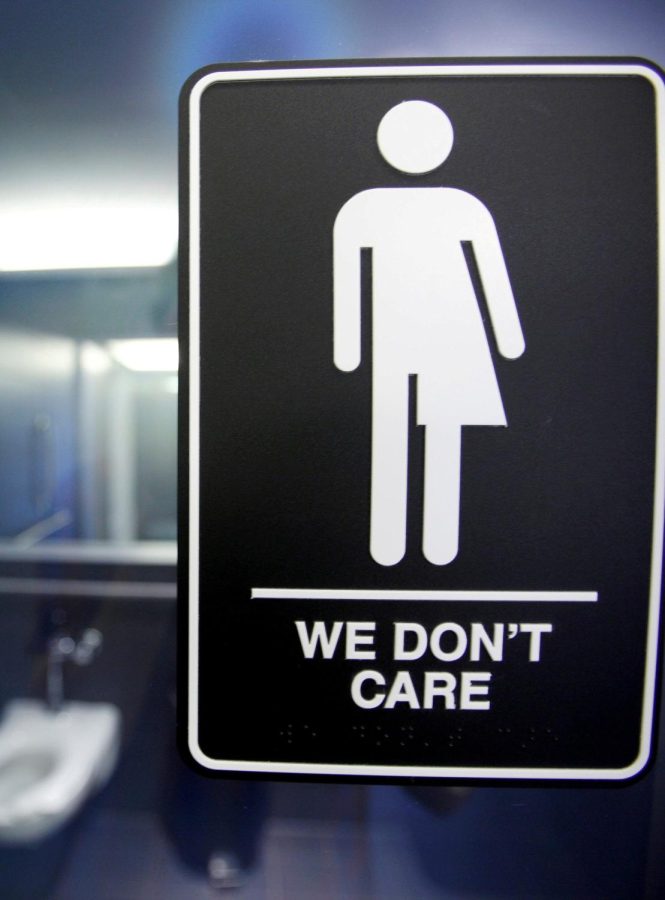The restroom situation in many schools discludes transgender students

More stories from Eva Harshman
A sign that shows the benefits of having a bathroom that isn’t gender-assigned
Opinions expressed in editorials on The Central Trend are the view of the individual writer and are not the opinion of the entire staff of The Central Trend or the Forest Hills Central staff or administration.
Usually, if somebody walks into the wrong bathroom, it’s both embarrassing, funny, and completely accidental. However, schools around the world are forcing certain students to use a restroom that they do not feel comfortable and safe in and one that does not match their gender.
If a student identifies as a man, they are a man. If a student identifies as a woman, they are a woman. If a student identifies as a non-binary person, they are a non-binary individual. While biologically, their sex might be either male or female and not align with how many males or females identify their gender, this does not invalidate their restroom preference and gender.
Bathrooms are labeled as “men” and “women.” A transgender woman is just as much a woman as a cisgender woman is, and a transgender man is just as much a man as a cisgender man. So, why are so many schools barring transgender students from using the bathroom they feel safest in?
Though hopefully many refer to a transgender student by the correct pronouns, students are often made to use the bathroom that aligns with their “given gender,” or what is on their school record, even if they fully identify as the opposite gender. The concept of “given gender” itself is invalidating to transgender students—using the gender on paper, despite the student not identifying with that gender, is highly disrespectful and highly inappropriate considering the fact that they are being intentionally misgendered.
It would be ideal if all students could be comfortable in the restroom that they use. Unfortunately, some transgender students may feel uncomfortable regardless of the restroom they are in due to the discrimination harassment they could face if they used the restroom of the gender that they have transitioned to.
Additionally, the term transgender does not only include transitions to a binary gender. Non-binary students also deserve a restroom where they feel safe, so truthfully, the simplest solution may be to add a few single-stall bathrooms that anyone can use—this could help smooth transitions from one restroom to another or provide a safe space for students who don’t feel like they belong in either of the restrooms that most schools have.
Not only is being in the correct restroom important for the mental well-being of students, but it also is vital for their safety. According to the Office of Justice Programs, one out of every two transgender people have been sexually assaulted or abused in their lives. Compared to the 45% of women who experience it and the 22% of men who do (wcsap.org), this number is extremely high for all transgender people, regardless of their gender. Although all sexual violence should have steps taken to prevent it and help those survivors, transgender people have a significantly higher chance of being a victim of sexual violence.
Due to the violence—especially sexual violence—that transgender students experience, it is important that they are as safe as possible, which may include extra measures. A single-stall restroom would ensure the privacy that they may need if a student would prefer that; forcing a transgender student into using a bathroom of the gender they do not align with could be just as dangerous and uncomfortable as a cisgender person being made to use the wrong restroom.
Schools around the world often don’t realize the accommodations that transgender students may need to feel safe in their schools due to the unfair discrimination they experience. Though many may think they are making the right idea by making students use the bathroom that aligns with their “given gender,” this could create an unsafe environment for transgender students both physically and mentally.

Eva Harshman is a senior who is thrilled to be entering her fourth and final year on staff as Editor-in-Chief. Apart from writing for The Central Trend, she...




























































































Ellie McDowell • Dec 2, 2021 at 11:28 am
Eva, this editorial is phenomenal. It’s so informative, and it sheds light on a topic that is often skimmed over. I love this!
Kiera Kemppainen • Dec 2, 2021 at 10:51 am
Eva, I am seriously your biggest fan. you have such an amazing way with words, and your editorials are always wonderfully written and informative while showing your voice and opinion as well
Lisa Hovinga • Dec 3, 2021 at 7:26 am
Excellent article! Very informative. I thought this was coming from an educator at CHS. Your writing is phenomenal.